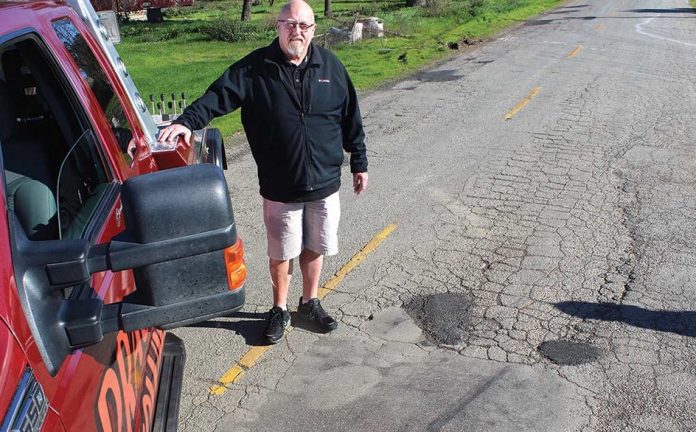
Gilroy City Councilmember Dion Bracco has seen his share of damaged vehicles with his towing business.
Perhaps the most common jobs Bracco’s Towing receives are from vehicles rendered immovable because of blown tires or cracked wheels. Potholes are one of the main culprits.
The situation is getting worse, according to the city’s own road-condition rating system.
Gilroy’s streets dropped from a “good” rating to “poor” over the last two years, according to a pavement survey conducted by the city.
The city’s 124 miles of roadways averaged a rating of 62 out of 100 on the Pavement Condition Index (PCI), a dip of seven points from 2017.
The summertime survey, released during the Gilroy City Council meeting on Jan. 27, determined that 43 percent of Gilroy’s roads were considered “good to excellent,” while the remainder are “fair to failed.”
Arterial roads in the city scored a “poor” rating of 56, while residential roads were rated 64.
Bracco said the report doesn’t fully capture the poor state of Gilroy’s roads. He suggested the council allocate $3 million annually for roads, up from the current $1.8 million, as a way to “make a dent” in repairs.
“We spend so much money on consultants and project managers that there’s no money to spend on construction,” he said.
Expressing frustration over the state of Gilroy’s streets, Bracco pointed to San Ysidro Avenue as an example, saying the main route to St. Louise Regional Hospital has “potholes inside of potholes inside of potholes.”
“In business, you don’t just let your stuff fall apart like this,” he said. “We owe the residents to at least try to fix their streets.”
According to public works engineer Nirorn Than, the city would have to invest $34.1 million over the next five years to increase its pavement rating to 70. Currently, the city invests $1.8 million annually into the roads.
With construction costs continuing to rise, studies show that every $2 spent on preventive maintenance would save $4-$8 on future restoration costs, according to city staff.
Mayor Roland Velasco said he was “very, very disappointed” in the report, mainly because the council has dedicated a little more than $3 million over the last three years on road improvement.
“I was hoping that we would at least be neutral, if not see some sort of marginal increase,” he said. “The streets that are rated 70 or above are being countered by the bad streets that are getting worse and worse.”
In a comparison of 15 Bay Area cities, Gilroy’s PCI ranked last, one point below Monte Sereno. Neighboring Morgan Hill’s roads were rated at 71.
Councilmember Carol Marques said she was angry after reading the report, adding that the city needs to do a better job in allocating its money for the benefit of residents.
“When you have a leak in your roof and it’s ruining your possessions, you don’t take a trip to Hawaii,” she said. “You take care of your house. This is our house. I truly believe that our citizens deserve something.”
Gilroy resident Ron Kirkish, a frequent attendee at council meetings who has followed city street projects closely, believes that the 2014 failure of Measure F, a half-cent sales tax with a portion of revenue going toward street repair, has contributed to the worsening conditions of city streets. According to a 2013 city public works report, Gilroy’s roads were rated 76, but engineers warned that maintaining the status quo of road funding was not sufficient.
“Now the problem has gone over the cliff,” said Kirkish. “It’s either going to get worse, or cost more money in the long run.”
One major repaving project in the city is currently on hold “due to the weather and other project-related conditions,” according to city officials. First Street/Highway 152 is slated to be repaved by Caltrans from the Highway 101 on-ramps to Santa Teresa Boulevard.














